Installing a pump in a heating system: an analysis of basic installation rules and tricks
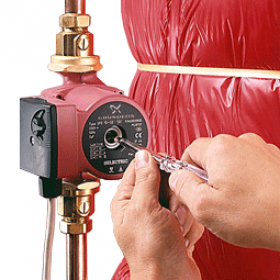
For a uniform distribution of heat in a house equipped with an autonomous heating system, various models of circulation pumps are used. This equipment provides forced circulation of the coolant through pipes and batteries. In this case, heating of radiators is carried out simultaneously in all rooms, regardless of their remoteness from the heating boiler.
The pump is installed for heating in accordance with the manufacturer's instructions, which describes in detail the installation process of this equipment. In practice, several methods have been tested for the location of pumping units in the heating system of a private house. In each case, the owner of the object selects the most suitable option, taking into account the type of boiler used and the expansion tank, the type of heating system, and the presence of additional elements.
Content
Choosing the right machine
When choosing a circulation pump for an autonomous heating system, they are guided by two main criteria - unit productivity and pressure. The first of these parameters characterizes the volume of coolant that the unit can pump over a certain period of time, and the second indicates the height at which the pump can lift the liquid. In addition, you must consider:
- The cross section of the pipes to which the circulation pump will be connected.
- Dimensions of the space reserved for the installation of the pumping unit.
- Maximum coolant temperature.
- Power and throughput of the heat generator.
- The volume of heated rooms.
We already talked about the classical calculation method in the article Calculation of the circulation pump for heating in examples and formulas. At the same time, there is a simpler method that can be used both for preliminary costing and for checking the results of more thorough calculations. It is based on the requirement that the circulation pump must pump a triple volume of its filling through the heating system in one hour of operation.
The latter value can be indirectly estimated by the power characteristics of the boiler. If the thermal unit was selected according to the rules, then for every kilowatt taken from its technical passport, at least 15 liters of coolant are necessary. It is enough to multiply the power of the heat generator in kW by 15 and make a correction of 20% to estimate the filling of heating circuits with sufficient accuracy.After the coolant volume is calculated, it will not be difficult to calculate the required capacity of the circulation pump in l / min - for this, filling the circuits in liters must be multiplied by three and divided by sixty. If we take a heating system with a boiler with a capacity of 15 kW as an example, then we can assume that the volume of liquid in all its branches is approximately equal to 270 liters (Q = 15 kW x 15 l + 20%). For forced circulation of the coolant, you need a pump with a flow rate of at least 0.81 m3/ hour or 13.5 l / min.
The required pressure value of the circulation pump can also be determined without going into complex mathematical calculations. To do this, you can use the formula N = X * K, where X is the number of storeys of the building, including the basement, and K is the correction factor equal to 0.7-1.1 for traditional two-pipe heating circuits and 1.2-1.85 for collector-beam circuits. So, if we calculate the hydraulic resistance of the collector heating system of a two-story building with a basement (the number of levels is three), then we need a pump with a pressure of 3x1.85 = 5.55 m.
The obtained values will already be enough to decide on a specific model of a circulation pump of any manufacturer. To do this, on the graphs of the hydraulic characteristics of centrifugal units find the operating point - it is at the intersection of the segments drawn from the abscissa axis (productivity) and ordinates (pressure). The best position of the operating point is the middle third of the graph, which corresponds to the maximum efficiency.
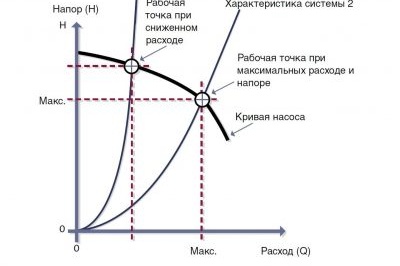
A graph of the hydraulic characteristics of the circulation pump allows you to analyze whether the unit meets the requirements for pressure and performance
To get a sufficient reserve in both directions, you should focus on the curve built for the average speed of the circulation pump. In this case, it will be possible to reduce its power with excessive noise or increase if the coolant at the inlet to the boiler has an unacceptably low temperature.
Features of the device of the heating system with pump circulation are studied in this article:https://aquatech.tomathouse.com/en/otoplenie/razvodka-otopitelnoj-sistemy/otopleniye-s-nasosnoj-cirkulyaciej.html
Thermal valves installed in many heating systems regulate the room temperature in accordance with the specified parameters. The valve closes when the temperature rises. In this case, the hydraulic resistance increases and, accordingly, the pressure increases. These processes are accompanied by the appearance of noise, which can be eliminated by moving the pump to low speed. Pumps with built-in electronics that can smoothly control pressure drops depending on changes in the amount of water cope more effectively with this task.
Read more about how to choose such a pump in the articles: Selection of a circulation pump for heating.
Determination of the place of the pump inlet into the system
When installing a circulation pump, it is necessary to take into account not only the recommendations of the manufacturers, but also the possibility of periodic maintenance. More recently, pumps with a “wet” rotor were recommended to be installed exclusively on the return line - it was believed that they would work this way much longer, since they would be in a more gentle temperature regime.

A typical connection diagram for a pump providing forced circulation of a heat carrier to an autonomous heating system of a private house or a country cottage
Modern units are designed for long-term contact with hot liquid, so they can safely be installed on the supply side. Moreover, experts often recommend mounting the pump on the supply pipe in order to increase the pressure in the suction zone.In this case, the indicated section will have the highest temperature, so it is imperative to make sure that the electrical device is capable of contacting with high-temperature liquid. The advantages of this method can be appreciated, for example, by owners of warm water floors, since in this case the formation of air jams is excluded.
A distribution comb is used to optimize the heating circuit. Details:https://aquatech.tomathouse.com/en/otoplenie/kotelnaya/grebenka-dlya-sistemy-otopleniya.html
For heating systems with membrane tanks, on the contrary, it is recommended to install a bypass with a pump on the return side, closer to the expansion tank. If such a scheme complicates the maintenance of the pump, then it is cut directly into the line, be sure to equip the circuit with a check valve.
The circulation pump and its piping elements: recommendations of specialists
Choosing a circulation pump and deciding on the place of its installation is only half the battle. It is equally important to correctly perform the strapping - only in this case you can count on a long, trouble-free operation and the possibility of comfortable maintenance of the unit. There is nothing complicated in the recommendations of specialists:
- The pump installation site should be equipped with ball valves. With their help, it will be possible to cut off the unit from the coolant during preventive or repair measures.
- On the inlet side of the coolant, a coarse filter must be installed, which will serve as a barrier to mechanical particles. As practice shows, the presence of such a device slows down the process of abrasive wear of the impeller by several times. If we talk about the danger of damage to the pump, then the importance of filtration is completely difficult to overestimate.
- The highest end of the bypass should be equipped with a vent valve.
- The direction of movement of the coolant should coincide with the arrow on the device.
- Since the pumped coolant performs cooling and lubrication in wet-type pumps, the rotation axis must be parallel to the horizontal.
- To ensure tightness, the mating parts and their joints are sealed with gaskets and sealants.
It is equally important to properly connect the pump to the mains. The type and cross-section of the cable must correspond to the power of the unit, and the connection must be made only with protective earth.
Basic installation rules
Any equipment is supplied accompanied by the manufacturer’s instructions, which reflects all the important information about its device, operating principle and installation rules. Having carefully read this technical document, you can understand the basic rules for handling it.
It is very important for self-installation to select the desired position of the product relative to the horizon. The location of the motor shaft must be strictly horizontal. Otherwise, air locks may form which will leave the bearings without lubrication and adequate cooling. This will lead to quick wear of parts and rapid breakdown of equipment. There is an arrow on the pump housing, in the direction of which the coolant in the system should move.
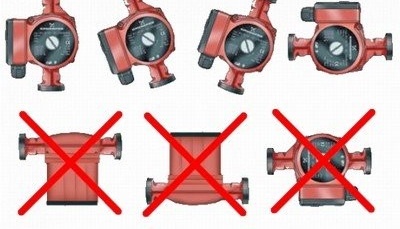
Options for the correct and incorrect location of the circulation pump with a "wet" rotor. It is strictly forbidden to place equipment as shown in the bottom row
The need for water filtration
A dirt collector is installed in front of the pump, the function of which is to filter the coolant. The dirt filter traps abrasive particles, sand, scale and other contaminants that have fallen into the water. If such elements get inside the pump, the impeller and bearings may be destroyed. Since the diameter of the insert for mounting the pump is small, you can use an ordinary coarse filter. Please note that the barrel used to collect various suspensions is directed down.Being in this position, the filter will not serve as an obstacle to the circulation of water. With partial filling, the barrel will not lose the ability to pass the coolant.
Important! Most filters are equipped with an arrow indicating the correct direction of water flow in the circuit. If you ignore the direction of the arrow, you will have to clean the sump much more often.
Location of the pump in the heating circuit
In principle, most models of modern pumps are capable of working equally well both on delivery and on return. The equipment can be embedded in any part of the heating circuit. It should be borne in mind that the duration of the bearings and plastic parts of the device will depend on the temperature of the coolant. Therefore, it is better to embed equipment on the return pipe after the expansion membrane tank and in front of the heating boiler.
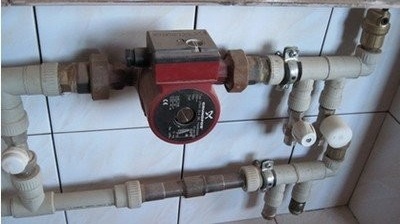
One of the options for the correct insertion of the circulation pump into the pipeline of the heating system of a private house with a loop length of not more than 80 meters
What is a bypass for?
The circulation pump is a volatile device. In the event of a power outage, the heating system must operate under natural circulation conditions. To do this, it is necessary to minimize the resistance in the circuit by reducing the number of bends and turns, as well as using modern ball valves as stop valves. In the open state, the clearance in the ball valve coincides with the diameter of the pipe.
The circulation pump is installed on bypass, which is cut off from the main system using two ball valves. Such placement of equipment allows its repair or replacement without damage to the heating system of the house. In the off-season, the heating system can operate without a pump, which is shut off using all the same ball valves. When frosts intensify, the pump is put into operation, opening shut-off valves at its edges and closing the ball valve on the main circuit. So the flow direction of the coolant is adjusted.
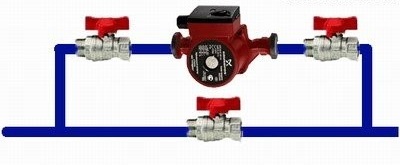
Installation of the circulation pump on the bypass (bypass pipe) using three ball valves provides the flow of coolant in the desired direction
Electrical connection
If the heating system is arranged on the principle of forced circulation, then in the event of a power outage, the pump should continue to operate from a backup power source. Therefore, it is recommended to install an uninterruptible power supply that will allow the heating system to function for a couple of hours. This time is usually enough for specialists to eliminate the cause of an emergency power outage. Extend the battery life of equipment can external batteries connected to a backup power source.
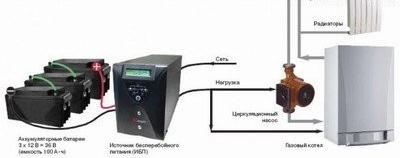
Connecting the pump to an uninterruptible power supply (UPS), which is additionally reinforced by three battery systems, connected in series in a single circuit
Carrying out the electrical connection of the equipment, it is necessary to exclude the possibility of moisture and condensate getting into the terminal box. A heat-resistant cable is used if the coolant is heated in the heating system by more than 90 ° C. The power cable may not come into contact with the pipe walls, motor, or pump housing. The power cable is connected to the terminal box on the left or right side, while the plug is rearranged. With a lateral arrangement of the terminal box, the cable is run only from the bottom. And yes, grounding is required!
The following material will help answer the question of why installing a circulation pump:https://aquatech.tomathouse.com/en/otoplenie/razvodka-otopitelnoj-sistemy/sistema-s-prinuditelnoj-cirkulyaciej.html
Verification of work and commissioning
After completion of installation work, the heating system is filled with water.Then, air is removed by opening the central screw located on the cover of the pump housing. Emerging water will signal the complete removal of air bubbles from the device. After that, the pump can be started up.
After reading the instructions and reading this article, you can carry out installation work yourself. If you do not understand how to install the pump for heating, then invite a professional craftsman.
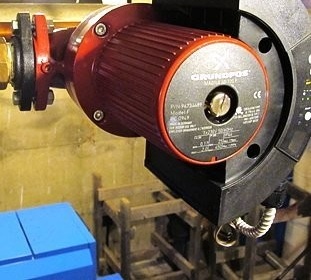

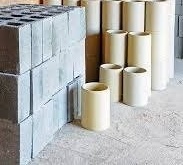
3 comments